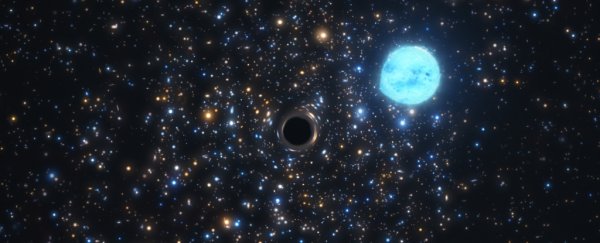Black holes are masters of stealth.
If they're not actively devouring material, which most stellar-mass black holes are not, they emit no radiation that we can detect. Therefore, we have to resort to other means of detecting them – such as looking for stars that seem to be in a binary orbit with… nothing.
Now, for the first time, astronomers have managed to pin down a black hole outside the Milky Way galaxy using this method.
From the motions of an orbiting star, they've identified a relatively small black hole in the Large Magellanic Cloud, a dwarf galaxy orbiting the Milky Way at a distance of around 160,000 light-years.
The black hole, named NGC 1850 BH1, was found in – you guessed it – NGC 1850, a cluster of thousands of stars. The detection suggests that this method could indeed prove key to finding black holes in densely populated clusters of stars, in the Milky Way and beyond.
"Similar to Sherlock Holmes tracking down a criminal gang from their missteps, we are looking at every single star in this cluster with a magnifying glass in one hand trying to find some evidence for the presence of black holes but without seeing them directly," says astrophysicist Sara Saracino of Liverpool John Moores University in the UK.
"The result shown here represents just one of the wanted criminals, but when you have found one, you are well on your way to discovering many others, in different clusters."
Most of the black holes we've detected outside the Milky Way have given themselves away by the radiation spewed out when they're active. The black hole itself emits no radiation, but the material falling onto it does – a lot of radiation, in fact.
Since 2015, too, we've detected a growing number of black holes from gravitational waves, the minute ripples they generate in space-time when two of the objects collide. However, with all these advances, that's still a mere drop in the cosmic ocean.
Astronomers have estimated there could be 100 million stellar-mass black holes in the Milky Way alone. We haven't detected even close to that many, which means there are some pretty significant gaps in our understanding of these enigmatic objects.
However, the way objects around black holes behave can be a telltale sign of their presence. Although they may be physically small and dark (a black hole 11 times the mass of the Sun would have an event horizon just 65 kilometers, or 40 miles, across), they still exert a gravitational influence on the space around them.
For example, when a black hole captures a star in a binary orbit, that star will start moving in a characteristic way. Although it might appear to be standing still from the distance at which we observe it, its light will change – the wavelength lengthening as the star moves away from us, and shortening as it moves towards us.
"The vast majority [of black holes] can only be unveiled dynamically," says astronomer Stefan Dreizler of the University of Göttingen in Germany.
"When they form a system with a star, they will affect its motion in a subtle but detectable way, so we can find them with sophisticated instruments."
Saracino and her team collected two years of data using the Very Large Telescope's Multi Unit Spectroscopic Explorer (MUSE), then analyzed these data looking for wavelength changes that indicate a binary star, ruling out any system with a visible companion.
The result of all this painstaking work was the discovery of NGC 1850 BH1. Its companion star is about 5 times the mass of the Sun, and is right at the end of its main-sequence lifespan. It's very close to the black hole, with an orbital period of just 5 days – so close that, when the star puffs up as it starts to die, material is likely to start siphoning onto the black hole.
But there's another reason the discovery is so fascinating. The star cluster NGC 1850 is very young, cosmically speaking – just 100 million years old. NGC 1850 BH1 represents the potential to find even more, younger black holes, which in turn could help us understand how these objects form and evolve.
Finding black holes in young star clusters could help us understand the evolutionary stages between a massive star and a neutron star or black hole, and population statistics for black holes in star clusters. Since star clusters are where astronomers think black hole and neutron star collisions are most likely to occur, this also has implications for the field of gravitational wave astronomy itself.
"Every single detection we make will be important for our future understanding of stellar clusters and the black holes in them," notes astronomer Mark Gieles of the University of Barcelona in Spain.
The research has been published in the Monthly Notices of the Royal Astronomical Society.
